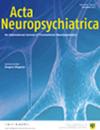Measuring Dispositional Empathy in South African Children.
IF 2.5
4区 医学
Q1 Medicine
引用次数: 0
Abstract
OBJECTIVE Empathy is a key factor to examine in development, because of its predictive associations with both aggression and successful prosocial behavior. However, established measures of empathy for Low-to-Middle Income Countries, including South Africa, are lacking. In children, parent-report measures are key. However, a local study examining empathy and aggression (Malcolm-Smith et al., 2015) found poor psychometric performance for a widely used parent-report measure of dispositional empathy, the Griffith Empathy Measure (GEM). We thus investigated which of two questionnaires measuring dispositional cognitive and affective empathy perform better in this context. METHOD We contrasted internal consistency reliability of a simplified version of the GEM (SGEM; n = 160) and a parent-report version of the Questionnaire of Cognitive and Affective Empathy (QCAE; n = 440) in a low-mid socio-economic status sample. Convergence between the measures and factor structure were also assessed. RESULTS The parent-report version of the QCAE performed well as a measure of child dispositional cognitive and affective empathy, with good reliability (overall α= .90 vs. SGEM α= .63), and confirmatory factor analysis supporting the two-factor structure. The SGEM's reliability and failure to correlate with QCAE indicated poor psychometric performance. CONCLUSION This is the first psychometric evaluation of the QCAE as a parent-report measure, and our results indicate that it should prove useful for future assessments of dispositional empathy in children across a variety of contexts.测量南非儿童的移情倾向。
目的移情是研究发展中的一个关键因素,因为它与攻击行为和成功的亲社会行为都有预测关联。然而,包括南非在内的中低收入国家缺乏对同理心的既定测量方法。对于儿童来说,家长报告是关键。然而,当地一项关于移情和攻击行为的研究(Malcolm-Smith 等人,2015 年)发现,一项广泛使用的家长报告型移情测量法--格里菲斯移情测量法(GEM)的心理测量性能不佳。因此,我们研究了两种测量认知和情感移情倾向的问卷,哪一种在这种情况下表现更好。方法我们在一个中低社会经济地位的样本中对比了简化版移情测量(SGEM;n = 160)和家长报告版认知与情感移情问卷(QCAE;n = 440)的内部一致性可靠性。结果作为对儿童认知和情感移情倾向的测量,家长报告版的 QCAE 表现良好,具有良好的可靠性(总体 α=.90 vs. SGEM α=.63),确认性因子分析支持双因子结构。SGEM 的可靠性和与 QCAE 的相关性不佳,表明其心理测量性能较差。结论 这是首次对 QCAE 作为家长报告测量方法进行心理测量评估,我们的结果表明,该方法将被证明有助于未来在各种情境下对儿童的处置性移情进行评估。
本文章由计算机程序翻译,如有差异,请以英文原文为准。
求助全文
约1分钟内获得全文
求助全文
来源期刊

Acta Neuropsychiatrica
医学-精神病学
CiteScore
8.50
自引率
5.30%
发文量
30
审稿时长
6-12 weeks
期刊介绍:
Acta Neuropsychiatrica is an international journal focussing on translational neuropsychiatry. It publishes high-quality original research papers and reviews. The Journal''s scope specifically highlights the pathway from discovery to clinical applications, healthcare and global health that can be viewed broadly as the spectrum of work that marks the pathway from discovery to global health.
 求助内容:
求助内容: 应助结果提醒方式:
应助结果提醒方式:


